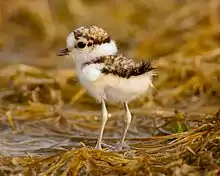| Charadrius | |
|---|---|
 | |
| Killdeer (Charadrius vociferus) | |
| Scientific classification | |
| Domain: | Eukaryota |
| Kingdom: | Animalia |
| Phylum: | Chordata |
| Class: | Aves |
| Order: | Charadriiformes |
| Family: | Charadriidae |
| Subfamily: | Charadriinae |
| Genus: | Charadrius Linnaeus, 1758 |
| Type species | |
| Charadrius hiaticula (common ringed plover) Linnaeus, 1758 | |
| Species | |
|
See text | |
| Synonyms | |
Charadrius is a genus of plovers, a group of wading birds. The genus name Charadrius is a Late Latin word for a yellowish bird mentioned in the fourth-century Vulgate. They are found throughout the world.
Many Charadrius species are characterised by breast bands or collars. These can be (in the adult) complete bands (ringed, semipalmated, little ringed, long-billed), double or triple bands (killdeer, three-banded, Forbes', two-banded, double-banded) or partial collars (Kentish, piping, snowy, Malaysian, Javan, red-capped, puna).
They have relatively short bills and feed mainly on insects, worms or other invertebrates, depending on habitat, which are obtained by a run-and-pause technique, rather than the steady probing of some other wader groups. They hunt by sight, rather than by feel as do longer-billed waders like snipe.
Species of the genera Aegialites (or Aegialitis), Thinornis, and Elseyornis are now subsumed within Charadrius. The former genus name Thinornis combined the Ancient Greek this meaning "beach" or "sand" with ornis meaning "bird".[1]
Taxonomy
The genus Charadrius was introduced in 1758 by the Swedish naturalist Carl Linnaeus in the tenth edition of his Systema Naturae.[2] The name had been used (as Charadrios sive Hiaticula) by the Italian naturalist Ulisse Aldrovandi in 1603 for the common ringed plover.[3] The word is Late Latin and is mentioned in the Vulgate Bible. It derives from the Ancient Greek χαραδριος/kharadrios, an unidentified plain-coloured nocturnal bird that was found in ravines and river valleys (from kharadra, "ravine").[lower-alpha 1][5] The type species is the common ringed plover.[6] However, it appears that the taxonomy of “Charadrius” may be erroneous, as for example the Kentish plover is more closely related to lapwings than it is to, say, the greater ringed plover. Hence, the either all members of Charadriidae, excluding Pluvialis are grouped in a single genus, Charadrius, or the genus is reduced to the Greater ringed plover, Piping plover, Semipalmated plover, and Killdeer.[7]
Species
The genus originally contained 33 species. However, in December 2023, The International Ornithologists' Union incorporated all species under Thinornis and Elseyornis into Charadrius, and some species of Charadrius are now placed in the genus Anarhynchus. As a result, Charadrius now consists of only 11 species:[8]
- Killdeer Charadrius vociferus Linnaeus, 1758
- Common ringed plover Charadrius hiaticula Linnaeus, 1758
- Semipalmated plover Charadrius semipalmatus Bonaparte, 1825
- Piping plover Charadrius melodus Ord, 1824
- Hooded plover Charadrius cucullatus Vieillot, 1818
- Forbes's plover Charadrius forbesi (Shelley, 1883)
- Three-banded plover Charadrius tricollaris Vieillot, 1818
- Black-fronted dotterel Charadrius melanops Vieillot, 1818
- Shore plover Charadrius novaeseelandiae Gmelin, JF, 1789
- Little ringed plover Charadrius dubius Scopoli, 1786
- Long-billed plover Charadrius placidus Gray, JE & Gray, GR, 1863
Another species, the Auckland Islands shore plover (Charadrius (Thinornis) rossii), known from just one specimen collected in 1840, is now generally considered to be a juvenile shore plover whose location was incorrectly recorded.[9]
Gallery
 Black-fronted Dotterel (C. melanops)
Black-fronted Dotterel (C. melanops) Semipalmated plover (C. semipalmatus)
Semipalmated plover (C. semipalmatus)_right_in_the_middle_of_the_S59_Road_(11926451373).jpg.webp) Three-banded plover (C. tricollaris) eggs on open ground
Three-banded plover (C. tricollaris) eggs on open ground Little ringed plover (C. dubius) chick
Little ringed plover (C. dubius) chick
Notes
References
- ↑ Jobling, James A. (2010). The Helm Dictionary of Scientific Bird Names. London: Christopher Helm. p. 384. ISBN 978-1-4081-2501-4.
- ↑ Linnaeus, Carl (1758). Systema Naturae per regna tria naturae, secundum classes, ordines, genera, species, cum characteribus, differentiis, synonymis, locis (in Latin). Vol. 1 (10th ed.). Holmiae (Stockholm): Laurentii Salvii. p. 150.
- ↑ Aldrovandi, Ulisse (1599). Vlyssis Aldrovandi philosophi ac medici Bononiensis historiam naturalem in gymnasio Bononiensi profitentis, Ornithologiae (in Latin). Vol. 1. Bononiae (Bologna, Italy): Franciscum de Franciscis Senensem. pp. 536–537, Lib. 20 Cap. 67.
- ↑ Anonymous (1592). Biblia sacra vulgatae editionis (in Latin). Rome: Ex. Typographica Apostolica Vaticana. p. 92, Leviticus Chapter 11 Verse 19.
- ↑ Jobling, James A. (2010). The Helm Dictionary of Scientific Bird Names. London: Christopher Helm. p. 99. ISBN 978-1-4081-2501-4.
- ↑ Peters, James Lee, ed. (1934). Check-List of Birds of the World. Vol. 2. Cambridge, Massachusetts: Harvard University Press. p. 245.
- ↑ "Comprehensive taxon sampling and vetted fossils help clarify the time tree of shorebirds (Aves, Charadriiformes)". biorxiv. 24 September 2023.
- ↑ International Ornithologists' Union. Gill, Frank; Donsker, David; Rasmussen, Pamela (eds.). "IOC World Bird List 14.1" (xlsx). Retrieved 2023-12-20.
- ↑ Gill, Brian J.; Bell, B. D.; Chambers, G. K.; Medway, D. G.; Palma, R. L.; Scofield, R. P.; Tennyson, A. J. D.; Worthy, T. H. (2010). Checklist of the Birds of New Zealand (4th ed.). Wellington, N.Z.: Te Papa Press. ISBN 978-1-877385-59-9.
Further reading
- Les Christidis, Walter Boles: Systematics and Taxonomy of Australian Birds. CSIRO Publishing. 2008. ISBN 978-0-643-06511-6
_svg-element.svg.png.webp)

